Study Information for Test
1
Contents
1. Some comments
2. What
will be on the test
3. Equation
sheet
4. Test
format
5. Examples
of questions
1. Some comments
On problems, it is important to show how you reasoned from the information
given in the problem to your final answer. The correct final answer with
units is only worth 2-3 points. The remainder of the points are given
for the quality of your solution. You need to include the following to
receive full credit:
- All the information given in the problem with correct units (This may
include a diagram)
- A statement of what quantity you are trying to find.
- State explicitly what physics principle you are using to solve the
problem
- Solve for the unknown quantity in symbols explicitly before numberic
calculations
- Then substitute numbers with units and calculate the numeric answer
Extra credit will be given for checks made to see if the answer is
reasonable
Be prepared to make reasonable estimations and state your assumptions
when solving problems. Be aware of significant digits in your answers. (Keep
lots of digits until the final calculation, then round to the appropriate precision.)
Here are some really good tips
on test taking from Dr. Richard Felder's website at North Carolina State
University.
If you have ANY questions while taking the test, please be sure to
ask the instructor. The purpose of the test is not to give you trick problems
to catch you in an error. The purpose is to give you an opportunity to "show
what you know" ! The test problems are based completely on the reading,
the lectures, and the homework. If you understand the main ideas and how
to apply them, you'll do well.
2. What will be on the test
(Items in blue/Items in black will not be covered
on this test)
Be sure to carefully review your notes, especially when we've done things
that are not covered very well in the book. Looking over the individual class
days linked to the calendar on the class website will also help refresh your
memory. (Things to know from PHY
2048) For this test, you should be able to do the following things:
Chapter 22 Electric
Charge
- Be familiar with basis electric phenomena.
- To understand the charge model and be able to apply
to situations involving conductors and insulators.
- To understand polarization and the attraction between
neutral and charged objects.
- To understand and use Coulomb's law for point charges.
- To recognize and use the principle of superposition
for electric forces.
Chapter 23 Electric Field
- To begin the process of understanding the field
model and the concept of a field.
- To learn the electric field of a point charge..
- To use the principle of superposition to calculate
the electric field of multiple charges and of continuous distributions of
charge.
- To learn and use the electric field of common charge
distributions.
- To analyze the motion of charges and dipoles.
- To use the motion of charges and dipoles in simple
electric fields.
Chapter 24 Guass' Law
Chapter 25 Electric Potential
Chapter 26 Capacitance
Chapter 27 Current and Resistance
Chapter 28 Circuits
Chapter 29 Magnetic Fields
Chapter 30 Magnetic Fields
Chapter 31 Inductions and Inductance
Chapter 32 Maxwell's Equations
Chapter 33 Electromagnetic Oscillations
Chapter 34 Electromagnetic Waves
3. Equation sheet
You will need to know the following equations and under what conditions they
can be applied:
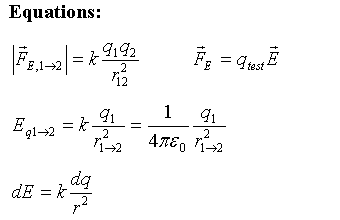
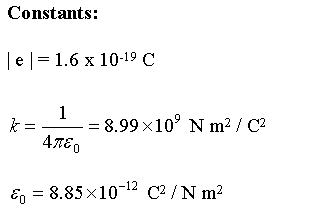
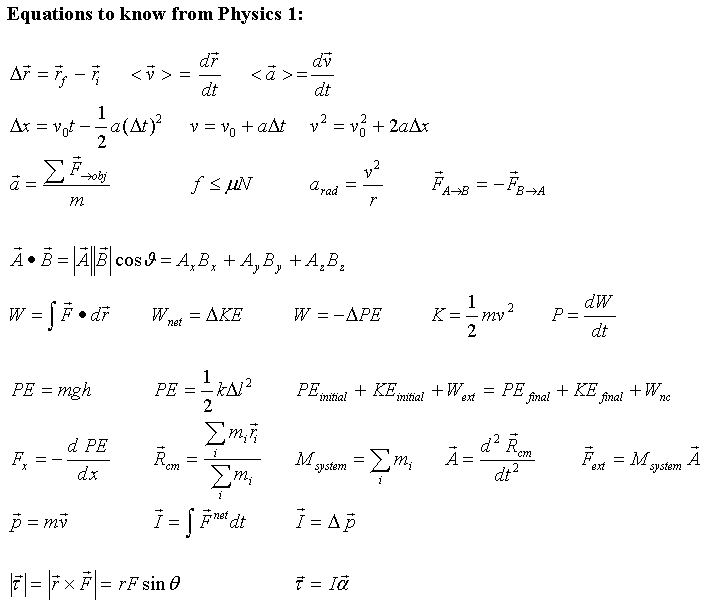
You should also know formulas for:
- area & circumference of a circle
- area & volume for a cube, a cylinder, & a sphere
You are expected to know the following conversions (rules of thumb):
- yard => meters
- miles => km
- inches => cm
- kg => lb
- quarts => liters
You should also know the following numbers to aid in visualization and estimation:
- your height and weight/mass in English and SI units
- The size of your hand
- The number of people who live in the Orlando Metropolitan Area
- The number of people in the US
- The distance from LA to New York
- The distance from Orlando to Miami
You are expected to derive specific equations you need from these
equations listed above. You will also be given any constants and conversions
you need. Unless told otherwise, you may use - 10 m/s/s for the acceleration
due to gravity.
4. Test Format:
Full period on Friday, February 7, 2003. A bonus of 5% will be awarded to any
group (with active contract) whose average Test score is 75% is higher.
| Part I |
|
| Group Problem using GOAL Protocol |
25 points
|
| Part II |
|
Multiple Choice or short answer question,
typically 4-5 parts
(no explanation
required, but no partial credit either) |
15-20 points |
| Estimation Problem |
15 points |
| Short Essay (typically at least 1/2 page) |
10 points |
| 2 Problems based on Homework and Lecture
– 15 points each |
30-35 points |
|
Total
|
100 points |
5. Practice Tests
This link is to a test I gave when I taught
this course as a SCALE-UP class at North Carolina State University. It intended
only to show you the type of questions I ask on tests and to practice using
what you have learned to prepare for Test 1. No solution is available, but you
may discuss your solutions with me or ask questions about the problems in office
hours, the review, or appointments made outside of class. Be aware that any
topic discussed above in Section 2 or anything we have discussed in class, in
the readings (other than recommended readings), or as homework is fair game
for the test. Topics used in problems on the actual test may differ from topics
covered in the practice test.
You will need adobe acrobat reader (v. 5 or better) to access the practice
test. Note that some tests contain material beyond what has been covered in
class so far. Our class will cover only what has been done up to the class before
the test.
6. Some Practice Questions
Multiple-Choice Practice Problem
In the figure on the left below is displayed a grid with coordinates measured
in meters. On the grid two charges are placed with their positions indicated
as black circles. The charge q1 is at the position (0,1), and the charge q2
is at the position (0, -1). In the middle figure below is displayed a set
of possible vector directions. On the right is a list of the components of
possible E fields.
For each of the three cases described below specify: an arrow corresponding
to the directions of the E field from the middle figure and a set of components
from the list on the right. Each of your answers should consist of a capital
letter and a small letter. (K stands for the Coulomb force constant, often
written 1/4 0.) Explain your reasoning for each choice.
(a) E field at the point (x,y) = (1,-1)
(b) E field at the point (x,y) = (-1,-1)
(c) E field at the point (x,y) = (-1,0)

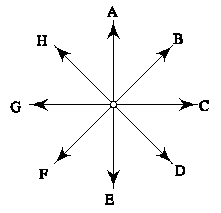
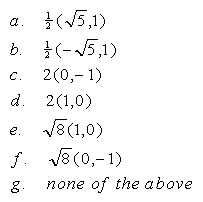
- This is a
link to other multiple-choice problems that will help test your understanding
of key ideas. The topics covered for this test can be found
in Test 1. Note that some ofthese multiple-choice questions will exend beyond
what we have learned so far in class and cover topics not included in Test
1.
Short essay questions
- Can your hand attract both a positive and a negatively object (one at
a time)? Explain
- Compare and contrast the force equation for universal gravitation with
the Coulomb's force equation.
- How can you induce a net charge on an object?
GOAL & Estimation Problems
- We know that within the limits of measurement, the magnitudes of the negative
charge on the electron and the positive charge on the proton are equal.
Suppose, however, that these magnitudes differed from each other by as little
as 0.0001% (1 part in a million). With what force would two copper pennies,
placed 1.0 m apart, then repel each other? (At 1 m apart, you may treat
the pennies as point charges.)
Homework and Lecture Problems
1. Four point charges are on the corners of a square. The two charges on
the top of the square each have a charge of -30 C while the two charges on
the bottom each have a charge of 30 C. The distance from one charge to the
center is 0.3 m. Find the electric field at the center.
- How do you know the direction of the electric field is reasonable?
- How would the electric field change if all the charges had the same value?
2. In the Millikan oil drop experiment, an atomizer (a sprayer with a fine
nozzle) is used to introduce many tiny droplets of oil between two oppositely
charged parallel metal plates. Some of the droplets pick up one or more excess
electrons. The charge on the plates is adjusted so that the electric force
on the excess electrons exactly balances the weight of the droplet. The idea
is to look for a droplet that has the smallest electric force and assume that
it has only one excess electron. This lets the observer measure the charge
on the electron. Suppose we are using an electric field of 3x104 N/C. The
charge on one electron is about 1.6x10-19 C. Estimate the radius of an oil
drop for which its weight could be balanced by the electric force of this
field on one electron.
3. A uniform, upward pointing electric field of magnitude 2.00 x 103 N/C
has been set up between two horizontal plates by charging the lower plate
positively and the upper plate negatively. The plates have length L = 10.0
cm and separation distance d = 2.00 cm. An electron is shot between the plates
from the left edge of the lower plate. The electron's initial velocity v0
makes an angle = 45 with the lower plate and has a magnitude of 6.00 x 106
m/s.
(a) Will the electron strike one of the plates?
(b) If so which plate, and how far horizontally from the left edge? (Show
your reasoning for both questions.)





